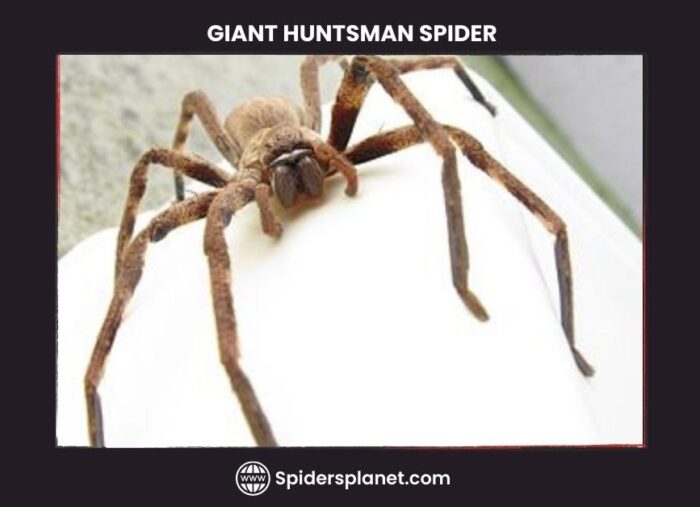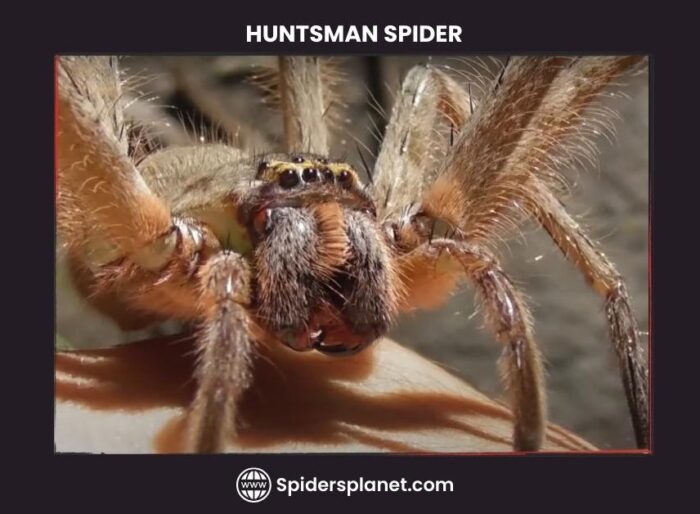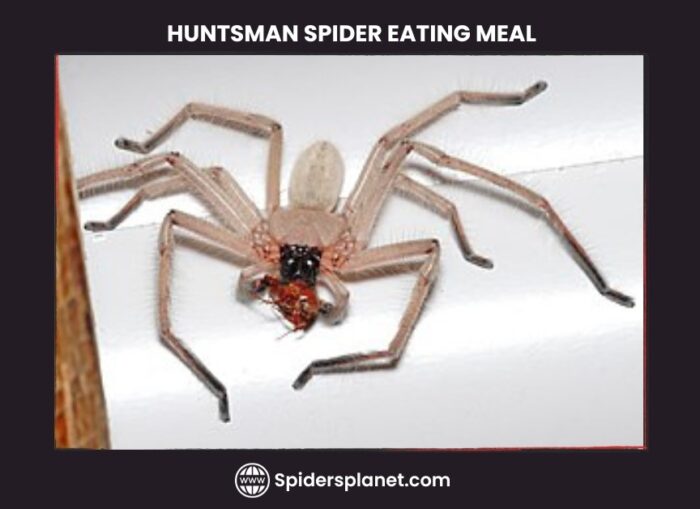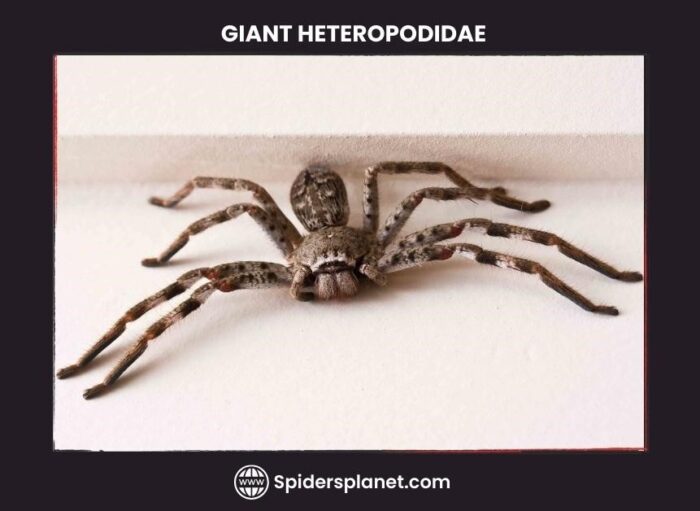Ever heard of the Huntsman spider? It is the wonder of the arachnid world—hairy, long-legged, and stealthy, especially at night. These guys are speedy acrobats, often zipping around walls and ceilings. But the good thing is that they are not being aggressive.
Huntsman spiders only bite if they are scared. So, let’s take a closer look at these nocturnal ninjas and discover that they might be more fascinating than frightening! To know more about their types, appearance, habitat, diet, and preventive measures, Keep reading!
Huntsman Spider Introduction
Scientific Name and Family Background:
Huntsman spiders, part of the Sparassidae family (used to be called Heteropodidae), get their name because they are super fast hunters. People also call them giant crab spiders because they can be big and look a bit like crabs.
Some of the larger ones are even called wood spiders since they like hanging out in wooded areas like forests and old wooden places. In southern Africa, there is a group of spiders named Palystes, and they go by the names rain spiders or lizard-eating spiders.

The Heteropodidae belongs to the Animalia kingdom, Arthropoda phylum, and Arachnida class, placing it among the diverse array of animals characterized by jointed legs and an external exoskeleton.
Huntsman Spider Species and Types:
The huntsman spiders, scientifically classified under the Sparassidae family, further break down into various genera and species. This diverse family includes nearly 96 genera and comprises over 1300 species (2021) of giant crab spiders.
Various Genera within the sparassidae family are Carparachne, Diminutella, Heteropoda, Leucorchestris, and Micrommata.
Each genus contributes to the overall richness of the sparassidae family, showcasing adaptations and characteristics that help these spiders thrive in different environments. There are many types of Huntsman spiders as:
- Giant Huntsman spider
- Tiger Huntsman spider
- Micrommata virescens
- Heteropoda
- Olios
- Red Huntsman spider
- Eusparassus
- Palystes superciliosus
- Wheel spider
- Delena
- Heteropoda davidbowie
- Cerbalus aravaensis
- Pandercetes
- Thelcticopis
- Leucorchestris arenicola
- Curicaberis
- Pseudopoda
- Paenula
People sometimes mix them up with baboon spiders, but those are different and not really close relatives. These Heteropodidae are speedy, big, and found in various places, but do not get them mixed up with other spider buddies!
What does a Heteropodidae look like?
Size and Body:
These spiders can be pretty big, especially the giant ones in Laos, with male spiders having legs that can stretch from 25 to 30 centimeters but average from 0.71 inches with a 5.9-inch leg span, though some species are much larger.

They weigh from 0.024 ounces to 0.37 pounds generally. Their bodies are flat, and their legs can fold specially. Similar to all spiders, Huntsman spiders also have eight legs.
Color:
Huntsman spiders usually have colors like light brown or gray on their topsides, and some kinds have clear black-and-white patterns underneath. Their legs are a bit spiky and make the rest of their bodies look a little furry. One cool type is called the banded huntsman (Holconia), and you can spot it by the stripes on its legs.
Some in the Micrommata group can be green-like leaves. Another one, the badge huntsman (Neosparassus), is bigger, brown, and kind of hairy. These special features help us recognize and appreciate the different types of huntsman spiders.
Identification:
Sometimes, people mix them up with tarantulas because of their size, but you can tell them apart by looking at their legs. Huntsman spiders have legs that go forward, kind of like a crab’s legs, while tarantulas have legs that go up and down. So, their unique leg structure helps us tell these cool spiders apart from others.
Habitat and Origin of Heteropodidae:
Huntsman spiders live in warm areas around the world, especially in tropical regions. Some, like the green Heteropodidae, even hang out in colder places like Northern and Central Europe.
A few types accidentally ended up in new spots, like the cane huntsman in New Zealand. In Florida, the huntsman spiders are from Asia and are considered invasive.
The huntsman spider’s origin goes back to Asia, where it has close relatives. However, there is a theory that these spiders hitched a ride to the United States through banana shipments from Central America.
So, they might have traveled a long way from their original home to end up in new places like the U.S. It is like a spider adventure, starting in Asia and making its way to different parts of the world through unexpected journeys.
Huntsman spiders like quiet spots – garages, sheds, even behind curtains. They can sneak into cars too, or in nature, you will find them under bark and rocks, earning the name “wood spider.” They are great at staying hidden until they decide to surprise you.
What They Like to Eat or Hunt?
Huntsman spiders have a varied diet, munching on small arthropods like butterflies, cockroaches, and even scorpions. Some can be real spider eaters and practice cannibalism. The larger huntsman spiders might surprise you; they can feast on bats, mice, and small lizards.

These speedy spiders do not make webs as adults; instead, they hunt for food like insects. You might find them in homes because they are quick and love munching on cockroaches. So, these spiders are like little hunters, enjoying a menu that ranges from tiny insects to even some not-so-tiny creatures.
Related Post: Knowing Your Jumping Spider Pet: A Comprehensive Guide
Heteropodidae Mating:
Male Heteropodidae of the species Heteropoda venatoria have a fascinating way of communicating with females. When they pick up on a special chemical signal (pheromone) left by a nearby female, these clever males anchor themselves securely to a surface and use their legs to send vibrations through their bodies to that surface.
Most of the sound comes from strong belly vibrations. The specific frequency and pattern of this sound act like a unique “love song” that helps females identify them. If a female is interested in mating, she will approach the male.
This rhythmic ticking sound, similar to a quartz clock, is something humans can hear in a quiet place. It is like a secret language of love among these spiders.
Lifecycle:
Female huntsman spiders lay eggs in a safe place, like under a rock or a piece of bark. The silk-woven sacs, carefully crafted by the female, serve as secure shelters where eggs are deposited and safeguarded. When the eggs hatch, out come the spiderlings.
These little ones grow by molting, which means shedding their old skin as they get bigger. After a few molts, they become adult spiders. As full-grown Heteropodidae find mates, the cycle continues, with the females laying more eggs.
Predators:
Huntsman spiders face a range of predators in their ecosystems, including birds, geckos, spiders, and wasps.
Venom:
Huntsman spiders may look big, but they usually run away from people because they are much larger. However, if you try to handle them or bother them in their hiding spots, they might bite, and it can be painful.
Although people have been bitten by huntsman spiders, there is no clear evidence that they use their venom to defend themselves. So, it is best to let them be and avoid getting too close.
Related Articles:
- Zebra Spider: Habitat, Diet, Reproduction & Facts
- Jumping Spider Baby Advise: From Spiderlings to Adulthood
Huntsman Spider’s Facts:
- Heteropodidae claim the title of the largest spiders in Australia, showcasing their remarkable size among the arachnid population in the region.
- Contrary to their formidable appearance, huntsman spiders exhibit surprising gentleness during courtship. In many species, males engage in a unique and rhythmic courtship ritual. They drum their abdomens or legs on the ground, creating vibrations that captivate the interest of females.
- Huntsman spiders exhibit exceptional maternal care, acting as vigilant guardians of their egg sacs. These devoted mothers ensure the safety of their offspring until the spiderlings hatch.
- Heteropodidae instead of just walking, they can do cartwheels, handsprings, and even backflips.
- The age of sexual maturity is about one year.

Preventive Measures:
Some people are okay with having huntsman spiders in their homes because they help control pests like roaches and even mice. Huntsman spiders are usually friendly and run away when they feel threatened.
But if someone really does not want them around, they can call pest control experts to catch and release the spiders somewhere else. It is a way to keep the balance between having a pest-free home and making sure everyone feels comfortable.
Final Thoughts:
Huntsman spiders are intriguing arachnids known for their unique characteristics. Despite their large size and distinct appearance, they are generally non-aggressive and play a crucial role in pest control.
Found in warm regions globally, they exhibit diverse species with varied colors and leg structures. Huntsman spiders exhibit captivating mating rituals, a unique life cycle, and remarkable maternal care, adding to their fascinating and intriguing nature. While they may perform acrobatic feats, it’s advised to avoid handling them to prevent potential bites.
Understanding and appreciating these spiders can help maintain a balance between coexistence and creating a comfortable living space.
Comprehensive FAQs:
Are Huntsman spiders dangerous?
Research and reports confirm that Huntsman spiders are not considered dangerous to humans. Their venom is not considered to be potent enough to cause serious harm, and they are not known to be aggressive.
Are Huntsman spiders poisonous?
Huntsman spiders are venomous, but their venom is not considered highly dangerous to humans. While Heteropodidae bites can be painful with swelling or redness, severe reactions are rare.
What is the world’s largest huntsman spider?
The largest Heteropodidae in the world is the Giant Huntsman spider (Heteropoda maxima), and it can have a leg span of up to 12 inches. These spiders are located in Laos and Vietnam.
Can we keep Huntsman spiders as pets?
Keeping huntsman spiders as pets is possible, but it’s not suitable for everyone. They need a spacious enclosure with lots of hiding spots and should be fed a diet of live insects.
Since huntsman spiders are known for their ability to escape, it’s crucial to have a secure and escape-proof enclosure for them.
Can a Huntsman spider kill you?
Huntsman spiders are not considered lethal to humans. While they are venomous and a bite may cause discomfort, such as pain and swelling, there have been no documented cases of a Heteropodidae causing a human fatality.
Some Bonus Answers to FAQs:
How do huntsman spiders get in your house?
Heteropodidae can enter your house through a variety of ways, including gaps and crevices, openings around pipes, and hitching a ride.
Are huntsman spiders dangerous to dogs?
Huntsman spiders are not typically dangerous to dogs. Their venom is not considered to be potent enough to cause serious harm to dogs, and they are not known to be aggressive towards dogs.
Why do Huntsman spiders run at you?
Huntsman spiders are generally not aggressive towards humans. Their usual behavior is to run away and avoid contact. However, if they feel threatened or cornered, they might exhibit defensive behavior, which could include running toward a perceived threat.
How to catch Huntsman spiders?
You can catch it in a container and release it outdoors.
Does the Huntsman spider eat mice?
Huntsman spiders are capable of eating mice, but their primary preference is for smaller insects. When insects are not readily available, they might resort to consuming mice.




Leave a Reply